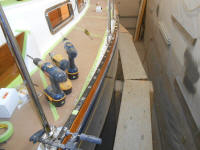
110 Cookson Lane | Whitefield, ME 04353 | 207-232-7600 | tim@lackeysailing.com
Snow Lily | Friday, February 15, 2013
To prepare ahead for the next coat of varnish, whether it happened immediately or later, I sanded all the cabinet doors and the companionway area, as well as the small painted trim pieces for the forward cabin, then vacuumed and solvent washed as needed. While I wanted to complete the varnish work on these areas, I had other items on the list that took precedence, so this would make it easier to do the next coat at a moment's notice, as the sanding was the most time-consuming part of each new coat.
With that complete, I geared up to install the genoa tracks. Picking up where I left off on the starboard side, I continued the dry fit process, bending the track into the curve of the toerail as I moved aft, drilling and installing fasteners as I went. Each fastener location (25 per track) required four separate steps: drill an oversize pilot hole (21/64") through the toerail itself; drill the proper size hole through the deck for creating 5/16" threads (#7); cut 5/16-18 threads in the deck; and install the 5/16" x 5" fastener.
Inevitably, a few of the genoa track fasteners ended up interfering with a pre-existing toerail fastener. I'd fastened the toerail 6" on center, the tracks were 4" on center, so I aligned the track in such a way as to avoid obvious conflicts, but over the full length of the track it was impossible to avoid an interference or two. There were three such locations on the starboard track. Noting the locations, I bypassed these holes during the initial dry fit. Once I removed the track again for final preparations, I dealt with the conflicts in different ways, depending on where exactly the track fastener fell in relation to the toerail fastener. In two instances, the holes matched up nearly perfectly, so I removed the toerail bung and existing fastener from these locations, and redrilled the holes for the larger genoa track fasteners.
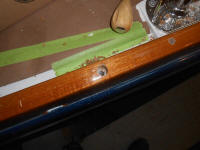
In the third instance, the overlap was in that awkward place where the hole didn't line up well enough to replace the toerail fastener, but wasn't far enough away to drill a second hole. In this location, my only choice was to use a wood screw in place of the through bolt--not a problem in the overall sense of track security.
Preparations complete, and after vacuuming and lightly solvent-washing, I installed the track permanently in a bed of teak-colored sealant. After cleaning up excess sealant above, down below I added fender washers and nuts to all the accessible fasteners. A few of the aftermost fasteners were inaccessible from inside, but the bolts went through the hull/deck flange and the imbedded aluminum strip put there by the original builder for this purpose.

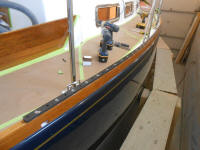
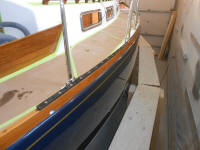
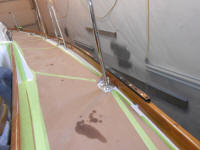
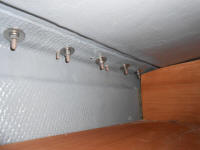
Before moving to the other side, I measured from the transom along the toerail to the forward end of the track, to give me a benchmark for starting the port side. After transferring this measurement to the port rail, I repeated the installation process. On the port side, a longer stretch of the fasteners would be inaccessible from within thanks to the molded quarterberth liner, so I took extra care to ensure that the holes I drilled and tapped stayed within the aluminum flange strip. Inside the boat, I still installed washers and nuts on the exposed fasteners forward of the nav station.
Because of minor differences between the sides and the toerail hole spacing, there was just a single location on the port side where the track and toerails conflicted; in this single instance I was able to replace the toerail fastener with one of the genoa track bolts in the same hole.
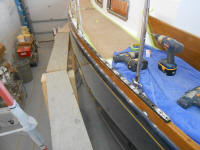

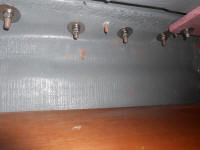
I slid on the new genoa lead cars, completing the job except for track end fittings.
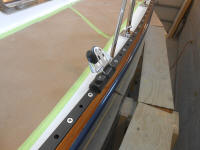
I moved on to the cockpit, and the traveler installation. Using the track wedges as drilling guides, I drilled holes through the deck for the 1/4" bolts that would secure the track, then prepared the holes in the usual way. To install the track, I inserted eight 1/4" hex-head bolts (four per side) through metal plates supplied by Harken, which I then slid into the track at each end; these slots held the fasteners securely and prevented spinning. Then, after applying sealant, I lined up the bolts on both sides and installed the track, bolting it securely with fender washers and nuts from beneath.
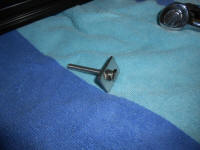

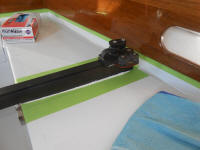
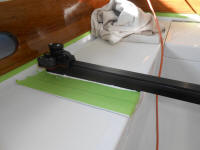
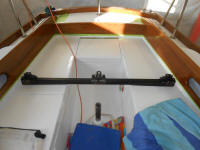

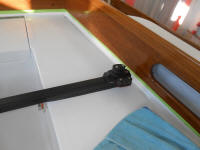
The new bow pulpit arrived earlier in the day, and while I didn't have time to fully install it, I wanted to check the fit. Holding the bases in line with some layout marks I'd made when I spec'd the pulpit earlier, and ensuring everything was symmetrical and lined up appropriately, I drilled and tapped the deck for a single fastener at each base location, which held the pulpit securely for now and would allow me to complete the layout and installation later. I was very pleased with the new pulpit, which fit well and looked excellent.
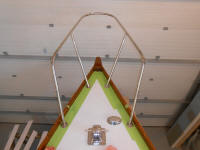
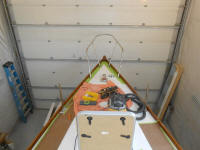
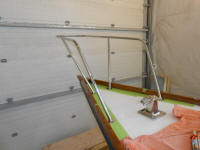
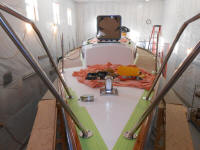
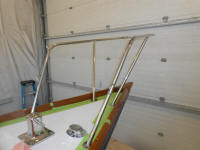
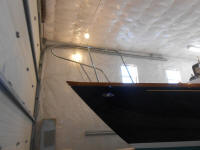
In keeping with the existing stern pulpit, I ordered the bow pulpit with a single rail, but with a provision for a lower lifeline. It appeared that all the fastener locations were going to end up through solid fiberglass, which would eliminate the need for any special hole preparation, so I expected wrap up the installation next time, which would allow my rigger to come and measure for the new lifelines.
Total Time on This Job Today: 8 hours

